Renovation of the Seat of the Constitutional Court
Renovation of the Seat of the Constitutional Court
The last remodelling of the building took place in the 1980s and 1990s. In 2010, the library of the Constitutional Court was modernised; other than that, only necessary repairs and maintenance have been performed. As the building needs to be maintained in a condition fit for its operation, yet offering a modern working environment, a medium-term plan for reconstruction and capital expenditure for 2014-2017 was drawn up in 2014. The plan envisaged the gradual revitalisation of the Constitutional Court building. The building is listed as a cultural monument, and enjoys general protection thanks to its architectural design. For that reason, a structural and historical survey of the building was commissioned in order to ensure the preservation, and restoration, if necessary, of the original architectural elements.
The survey revealed a time capsule placed under the coping stone on the occasion of the ceremonial unveiling of the building on 22 December 1878 by provincial hetman Adalbert Widmann. The capsule and its contents are currently deposited at the Moravian Provincial Archives. When work on the building was initiated in 2014, the first step was the renovation of sculptural décor on the parapet of the south and northern bays of the Constitutional Court's building: the sculptural allegories of the six virtues placed in groups of six.
The sculptures were created by Josef Schönfeld and Johann Eduard Tomola. Although the sculptures have been repaired several times over the last few decades, they were in very poor, in some cases even critical, condition. The condition of the original stone did not make it possible to return the sculptures to their original places on the exterior even after repair. Therefore, copies of all the sculptures were made and placed on the parapets in November 2014.
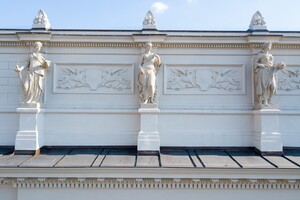
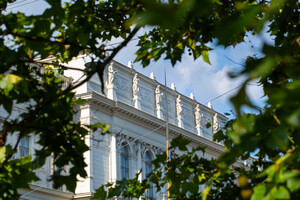
Following the necessary treatment, the original sculptures are kept on the premises of the Constitutional Court. Two of the original sculptures underwent complete restoration (the allegories of Justice and Prosperity) and were then put on display inside the building. The main entrance and foyer area were also restored in 2015.
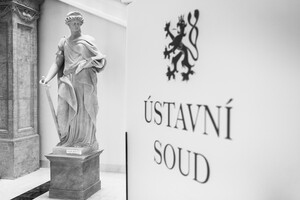
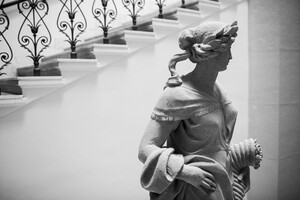
On the left side a restored alegory of Justice, on the right side a restored allegory of Prosperity
In 2017, the technically unsuitable state of the Assembly Hall of the Constitutional Court and the adjacent areas brought the Constitutional Court to the decision to renovate and restore it. A comprehensive architectural project followed, which did not only deal with this particular space. The Assembly Hall and the surrounding areas are, from an artistic and historical perspective, one of the most important parts of the interior of the building. From a social point of view, this is the space where representative activities of the Constitutional Court take place, for example, plenary sessions, international conferences, thematic lectures by renowned international experts in the field of law, and similar important events. The main idea of the project was to return this space to its original state and renew the original layout, which is most apparent in the Vestibule of the Assembly Hall, and, at the same time, ensure modern functioning pertaining to the current needs of the Constitutional Court.
In recognition of the historic and architectural significance of this space, the Constitutional Court launched an open architectural competition with the goal of finding the best architectural and renovation plan, inviting leading Czech architects Ladislav Kuba, Radko Květ and Jan Šesták as jurors. A plan by architects Ondřej Kafka and Darja Kafka was the winner of the competition.
The Assembly Hall of the former Moravian Parliament is a monumental two-storey space. The parterre is accessible from the Vestibule and the adjacent hallways. The balconies are on all sides of the upper level. The light is ensured by a large skylight in the Hall itself as well as above the Western Balcony.
A historical and technical analysis revealed that unsuitably executed adjustments and partial repairs had damaged the original appearance of the space. The progressive degradation of the plastering and stucco had caused webs of hairline fractures in the reliefs, stucco and marble surfaces. The woodwork elements and especially the carved lining of the doors to the Hall had also suffered damage. The original clarity of the decorative paintings was distorted by layers of dust and grease deposits. Part of the space (the Western Balcony) was closed due to its state of disrepair or remained unused because of the poorly planned adjustments when adding air-conditioning (North and South Balconies).
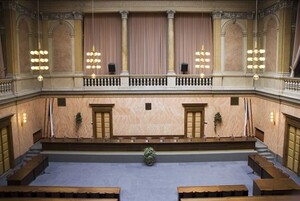
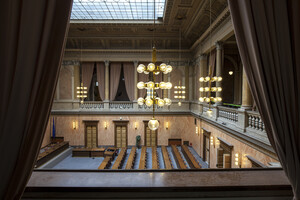
The Assembly (Plenary) Hall before restoration
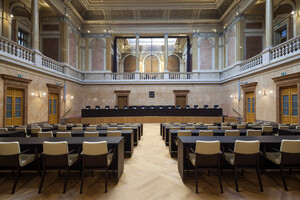
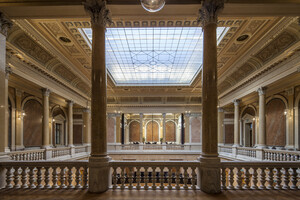
The Assembly (Plenary) Hall after restoration
Repairs of the Assembly Hall and its surroundings included the renovation of the wall and ceiling paintings, stone elements, stucco decorations, surfaces of fake marble and woodwork and steelwork. The renovation incorporated the balconies and also the Vestibule and courtrooms, which are both functionally and spatially connected to the Hall.
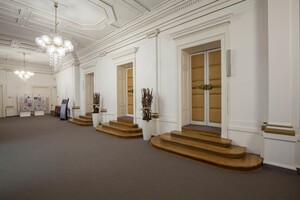
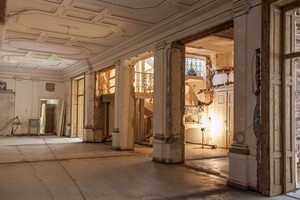
The Vestibul of the Assembly Hall before and in the course of reconstruction works
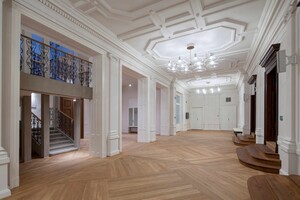
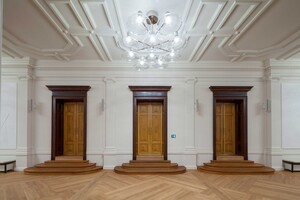
The Vestibule of the Assembly Hall after restoration
Further renovations concerned the iron structure of both skylights (Assembly Hall and Western Balcony), including replacing the glass and installing horizontal sun blinds and a new system of artificial lighting of the Hall and Western Balcony from above the skylights. The doors on the Western Balcony were put back into use. The floors were also renovated and returned to their original state; that is, the double floor on the balcony was reversed back to its original form and the sloped floor of the Assembly Hall was reverted to steps. At the same time, the floor was equipped with air-conditioning vents and a new, modern ventilation system was installed. Part of the renovation included the renewal of the furnishing of the court rooms with new furniture, audiovisual equipment and other indispensable devices.
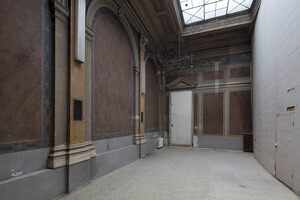
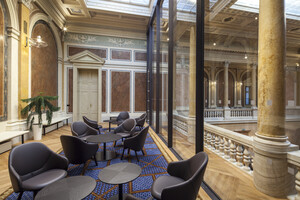
Before the renovation, the Western Gallery was not in use due its state of disrepair. The restoration gave birth to
a new representative meeting hall.
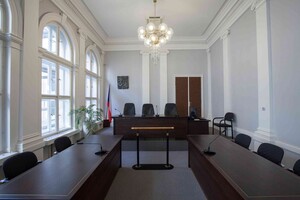
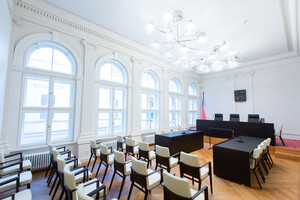
The Court has two identical-looking courtrooms. Both of them were restored. (A restored courtroom on the left side.)
In line with the architectural design, adjustments were made to the roof terraces of the southern-facing atriums of the building. The renovations began in October 2017 and were finished in October 2018. The first significant event in the newly renovated space was the celebration of the 100th anniversary of the founding of Czechoslovakia and 25th anniversary of the renewal of the constitutional judiciary in the Czech Republic.
Another important and prestigious room of the Constitutional Court is the hall known as the "Grand Council". Its full-scale renovation has been launched in the spring of 2022. It was based on a design created by the architectural office Architekti Hrůša a spol., Ateliér Brno, s. r. o. In this design, Professor Hrůša conceives the reconstructed space, i.e. the hall and its adjacent rooms, as a single unit whose individual parts naturally relate to each other. The hall was shaped after famous halls of the past, i.e. with an artistically rich ceiling with coffers. The new solution was inspired by the original square ceiling, where a strong role is played by the aesthetics of geometric shapes. The original ceiling had to be replaced because it was unstable and fragile. The lighting situation was not ideal either. The existing natural lighting provided by five windows was uneven and, even in combination with artificial lighting from the chandelier and fluorescent lamps, there was simply not enough light. The disparate lighting elements were thus replaced by a uniformly illuminated ceiling. The basic conceptual design of the room places its visitors on an imaginary path of the search for constitutionality. The seating arrangement for table meetings forms an incomplete circle, with its missing section filled in by a newly created recess containing the text of the Constitution. This cornerstone of Czech Law will thus become a symbolic, permanent and important participant in future meetings. The Constitution is guarded on its sides by State emblems cast in leaded glass and the carpet on the floor symbolises the uncertain surface of social waves – the fluidity of past and present. The reconstruction also affected the remaining prestigious and ceremonial spaces in the building, which lead from the meeting and private rooms of the President of the Constitutional Court through the reconstructed Grand Council to the facilities for constitutional officials. The hall itself has two entrances – a grand one for visitors and an internal one for staff. The construction work started in the spring of 2022 and consisted mainly of removing the non-original floor layers and the ceiling. A new partition at the head of the room was used to hide the cooling system, new timber flooring was laid in all areas, the wooden door panels were either refurbished or replaced, and the walls were resurfaced following a new electrical wiring installation. Finally, glass luminaires and State symbols from Czech manufacturers were installed. The interior was furnished with restored table furniture from the 1920s and complemented by refurbished leather-covered armchairs. The windows are covered with elegant velvet drapes, and white muslin curtains are used to separate the space from the outside traffic and the opposite building. The Grand Council hall has also been fully equipped with an audiovisual system for international teleconferences, including interpretation capabilities, and it is ready to welcome even the most important visitors from February 2023.
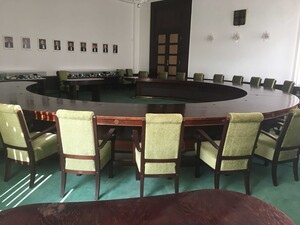
The Grand Council Room before renovation
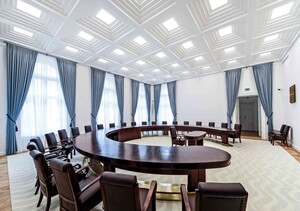
The Grand Council Room after renovation
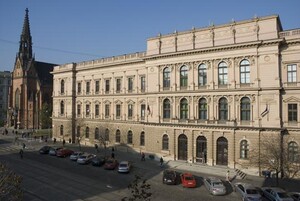
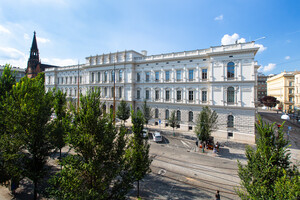
The seat of the Constitutional Court before and after renovation